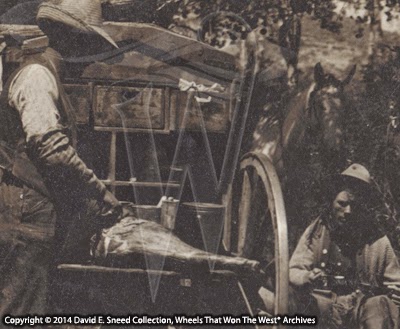Over the past twenty years, we’ve made astrong effort to uncover as much of America’s lost wheeled history aspossible. It’s been a long – andsometimes dry – road. Nonetheless, as welook back over the decades of research, there are plenty of successes withinthe individual ‘finds’ and overall groupings of period artifacts, imagery, andephemera. For those who may have onlyrecently signed up for this blog, the primary areas we focus on are the heavierfarm, freight, ranch, coach, military, and a few business vehicles.
Some of the fruits of our researchlabors can be seen in the thousands of old wagon images now held in the Wheels That Won The West® Archives. Within thatcollection, the Trail and Ranch Wagon category includes a respectable number ofperiod chuck wagon photos. Most areunpublished and rarely-seen examples of our nation’s early western and cowboyheritage. From these original images,we’re able to help dispense with guess work while establishing a supportablebackground for a myriad of historical questions.
 |
| This small portion of a larger photo shows the beginnings of a meal preparation on the back of an early Bain chuck wagon. |
Among the chuck wagon images in thearchives, there are a number of wagon brands represented. Legendary names like Mitchell, Bain, PeterSchuttler, Studebaker, Stoughton, Old Hickory, and more are shown in settingsfrom Texas and Colorado to the Dakotas, Wyoming, and Montana. While the images vary in condition, location,size, content, and vehicle brand shown, the central chuck wagon theme remainsthe same. Differences between campsites, clothing, and other equipment from the late 1800’s and early 1900’s canalso be seen. Sometimes a remuda isincluded in the photo. At other times,only a handful of cowboys, the cook, and wagon are represented.
 |
| This image is cropped from a large cabinet card depicting an early camp; replete with cowboys, tents, chuck wagon, bed rolls, cattle, and a remuda. |
When it comes to the design of the chuckbox, there seems to be no end to the variations. Differences not only include the exteriorshape of the box but the interior configurations as well. Close examination often points out distinctionsin even the smallest details. Contrasting table leg designs, latches, drawers, or even different ways ofattaching the pan boot help us more completely appreciate the individualpersonalities represented in every chuck wagon. One nineteenth century photo, which appears to be taken on the westernplains, shows a box-style coffee grinder tucked into a section of the chuckbox. It’s a departure from the morecommonly seen grinder mounted on the back of the upper sideboard. Another image shows a camp using buffalochips as a fuel source for the fire while others show coals from availablewood. Over and over we can see similar,yet distinct, characteristics represented in these vehicles and people. Looking through the old cameras, the imagesstare back at us, frozen in time, yet still alive with the fierce andindependent spirit that built the nation we call home.
As we continue to celebrate America’searly western wheels, we’re reminded that each of these primary source imageshas much to teach. Ultimately, bygrowing that base of information, we’re not only able to provide verifiable answersto questions that might otherwise remain unknown but, open new doors ofunderstanding and opportunity to future generations equally intrigued by thesubject.
Stay tuned… coming soon to this blog…One of the best original Bain Rack Bed wagons I’ve ever seen!